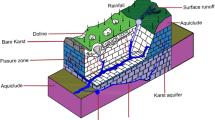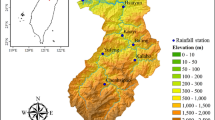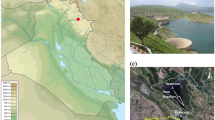Abstract
Reservoirs and dams are critical infrastructures that play essential roles in flood control, hydropower generation, water supply, and navigation. Accurate and reliable dam outflow prediction models are important for managing water resources effectively. In this study, we explore the application of three deep learning (DL) algorithms, i.e., gated recurrent unit (GRU), long short-term memory (LSTM), and bidirectional LSTM (BiLSTM), to predict outflows for the Buon Tua Srah and Hua Na reservoirs located in Vietnam. An advanced optimization framework, named the Bayesian optimization algorithm with a Gaussian process, is introduced to simultaneously select the input predictors and hyperparameters of DLs. A comprehensive investigation into the performance of three DLs in multistep-ahead prediction of outflow of two dams shows that all three models can predict the reservoir outflow accurately, especially for short lead-time predictions. The analysis results based on the root mean square error, Nash–Sutcliffe efficiency, and Kling–Gupta efficiency indicate that BiLSTM and GRU are the most suitable models to diagnose the outflow of Buon Tua Srah and Hua Na reservoirs, respectively. Conversely, the results of the similarity assessment of 11 hydrological signatures show that LSTM outperforms BiLSTM and GRU in both case studies. This result emphasizes the importance of determining the purpose and objective function when choosing the best model for each case study. Ultimately, these results strengthen the potential of DL for efficient and effective reservoir outflow predictions to help policymakers and operators manage their water resource system operations better.







Similar content being viewed by others
Data Availability
The data that support the findings of this study are available from the corresponding author, [N.T.G], upon reasonable request.
References
Adamowski J, Sun K (2010) Development of a coupled wavelet transform and neural network method for flow forecasting of non-perennial rivers in semi-arid watersheds. J Hydrol 390(1–2):85–91. https://doi.org/10.1016/j.jhydrol.2010.06.033
Ahmad SK, Hossain F (2019) A generic data-driven technique for forecasting of reservoir inflow: Application for hydropower maximization. Environ Model Softw 119:147–165. https://doi.org/10.1016/j.envsoft.2019.06.008
Aksoy H, Dahamsheh A (2018) Markov chain-incorporated and synthetic data-supported conditional artificial neural network models for forecasting monthly precipitation in arid regions. J Hydrol 562:758–779. https://doi.org/10.1016/j.jhydrol.2018.05.030
Alizadeh B, Ghaderi Bafti A, Kamangir H, Zhang Y, Wright DB, Franz KJ (2021) A novel attention-based LSTM cell post-processor coupled with bayesian optimization for streamflow prediction. J Hydrol 601:126526. https://doi.org/10.1016/j.jhydrol.2021.126526
Altman N, Krzywinski M (2015) Points of significance: Association, correlation and causation. Nat Methods 12(10)
Beiranvand B, Ashofteh P-S (2023) A systematic review of optimization of dams reservoir operation using the meta-heuristic algorithms. Water Resour Manag 37(9):3457–3526. https://doi.org/10.1007/s11269-023-03510-3
Bergstra J, Bengio Y (2012) Random search for hyper-parameter optimization. J Mach Learn Res 13(1):281–305
Bowden GJ, Maier HR, Dandy GC (2005) Input determination for neural network models in water resources applications. Part 2. Case study: forecasting salinity in a river. J Hydrol 301(1–4):93–107. https://doi.org/10.1016/j.jhydrol.2004.06.020
Bozorg-Haddad O, Zarezadeh-Mehrizi M, Abdi-Dehkordi M, Loáiciga HA, Mariño MA (2016) A self-tuning ANN model for simulation and forecasting of surface flows. Water Resour Manag 30(9):2907–2929. https://doi.org/10.1007/s11269-016-1301-2
Cho K, Van Merriënboer B, Bahdanau D, Bengio Y (2014) On the properties of neural machine translation: Encoder-decoder approaches. arXiv preprint arXiv:1409.1259
Coerver HM, Rutten MM, van de Giesen NC (2018) Deduction of reservoir operating rules for application in global hydrological models. Hydrol Earth Syst Sci 22(1):831–851. https://doi.org/10.5194/hess-22-831-2018
Döll P, Fiedler K, Zhang J (2009) Global-scale analysis of river flow alterations due to water withdrawals and reservoirs. Hydrol Earth Syst Sci 13(12):2413–2432. https://doi.org/10.5194/hess-13-2413-2009
Ehsani N, Fekete BM, Vörösmarty CJ, Tessler ZD (2016) A neural network based general reservoir operation scheme. Stoch Env Res Risk Assess 30(4):1151–1166. https://doi.org/10.1007/s00477-015-1147-9
El-Shafie A, Taha MR, Noureldin A (2006) A neuro-fuzzy model for inflow forecasting of the Nile river at Aswan high dam. Water Resour Manag 21(3):533–556. https://doi.org/10.1007/s11269-006-9027-1
Fang K, Kifer D, Lawson K, Shen C (2020) Evaluating the potential and challenges of an uncertainty quantification method for long short-term memory models for soil moisture predictions. Water Resour Res. https://doi.org/10.1029/2020wr028095
Frame JM, Kratzert F, Klotz D, Gauch M, Shalev G, Gilon O, Qualls LM, Gupta HV, Nearing GS (2022) Deep learning rainfall–runoff predictions of extreme events. Hydrol Earth Syst Sci 26:3377–3392. https://doi.org/10.5194/hess-26-3377-2022
Gal Y, Ghahramani Z (2016) Dropout as a bayesian approximation: Representing model uncertainty in deep learning. In international conference on machine learning (pp. 1050–1059). PMLR
Goodwin LD, Leech NL (2006) Understanding correlation: Factors that affect the size of r. J Exp Educ 74(3):249–266
Graf WL (2006) Downstream hydrologic and geomorphic effects of large dams on American rivers. Geomorphology 79(3):336–360. https://doi.org/10.1016/j.geomorph.2006.06.022
Greff K, Srivastava RK, Koutnik J, Steunebrink BR, Schmidhuber J (2017) LSTM: A search space odyssey. IEEE Trans Neural Netw Learn Syst 28(10):2222–2232. https://doi.org/10.1109/TNNLS.2016.2582924
Gutenson JL, Tavakoly AA, Wahl MD, Follum ML (2020) Comparison of generalized non-data-driven lake and reservoir routing models for global-scale hydrologic forecasting of reservoir outflow at diurnal time steps. Hydrol Earth Syst Sci 24(5):2711–2729. https://doi.org/10.5194/hess-24-2711-2020
Han Z, Long D, Huang Q, Li X, Zhao F, Wang J (2020) Improving reservoir outflow estimation for ungauged basins using satellite observations and a hydrological model. Water Resour Res 56(9). https://doi.org/10.1029/2020wr027590
Hanasaki N, Kanae S, Oki T (2006) A reservoir operation scheme for global river routing models. J Hydrol 327(1–2):22–41. https://doi.org/10.1016/j.jhydrol.2005.11.011
Hochreiter S, Schmidhuber J (1997) Long short-term memory. Neural Comput. https://doi.org/10.1162/neco.1997.9.8.1735
Hu C, Wu Q, Li H, Jian S, Li N, Lou Z (2018) Deep learning with a long short-term memory networks approach for rainfall-runoff simulation. Water 10(11):1543. https://doi.org/10.3390/w10111543
Jothiprakash V, Magar RB (2012) Multi-time-step ahead daily and hourly intermittent reservoir inflow prediction by artificial intelligent techniques using lumped and distributed data. J Hydrol 450–451:293–307. https://doi.org/10.1016/j.jhydrol.2012.04.045
Jung K, Bae D-H, Um M-J, Kim S, Jeon S, Park D (2020) Evaluation of nitrate load estimations using neural networks and canonical correlation analysis with k-fold cross-validation. Sustainability 12(1):400
Kasiviswanathan KS, Sudheer KP (2012) Quantification of the predictive uncertainty of artificial neural network based river flow forecast models. Stoch Env Res Risk Assess 27(1):137–146. https://doi.org/10.1007/s00477-012-0600-2
Khosravi K, Golkarian A, Tiefenbacher JP (2022) Using optimized deep learning to predict daily streamflow: A comparison to common machine learning algorithms. Water Resour Manag 36(2):699–716. https://doi.org/10.1007/s11269-021-03051-7
Kratzert F, Klotz D, Brenner C, Schulz K, Herrnegger M (2018) Rainfall–runoff modelling using Long Short-Term Memory (LSTM) networks. Hydrol Earth Syst Sci 22(11):6005–6022. https://doi.org/10.5194/hess-22-6005-2018
Kratzert F, Klotz D, Shalev G, Klambauer G, Hochreiter S, Nearing G (2019) Towards learning universal, regional, and local hydrological behaviors via machine learning applied to large-sample datasets. Hydrol Earth Syst Sci 23(12):5089–5110. https://doi.org/10.5194/hess-23-5089-2019
Latif SD, Ahmed AN (2023) Streamflow prediction utilizing deep learning and machine learning algorithms for sustainable water supply management. Water Resour Manag 37(8):3227–3241. https://doi.org/10.1007/s11269-023-03499-9
Le XH, Ho HV, Lee G, Jung S (2019) Application of Long Short-Term Memory (LSTM) Neural Network for Flood Forecasting. Water 11(7):1387. https://doi.org/10.3390/w11071387
McMillan HK (2020) A review of hydrologic signatures and their applications. WIREs Water 8(1). https://doi.org/10.1002/wat2.1499
Mohan S, Ramsundram N (2016) Predictive temporal data-mining approach for evolving knowledge based reservoir operation rules. Water Resour Manag 30(10):3315–3330. https://doi.org/10.1007/s11269-016-1351-5
Mohandes MA, Halawani TO, Rehman S, Hussain AA (2004) Support vector machines for wind speed prediction. Renew Energy 29(6):939–947. https://doi.org/10.1016/j.renene.2003.11.009
Ni L, Wang D, Singh VP, Wu J, Wang Y, Tao Y, Zhang J (2020) Streamflow and rainfall forecasting by two long short-term memory-based models. J Hydrol 583:124296. https://doi.org/10.1016/j.jhydrol.2019.124296
Nourani V, Hosseini Baghanam A, Adamowski J, Kisi O (2014) Applications of hybrid wavelet–Artificial Intelligence models in hydrology: A review. J Hydrol 514:358–377. https://doi.org/10.1016/j.jhydrol.2014.03.057
Pushpalatha R, Perrin C, Le Moine N, Mathevet T, Andréassian V (2011) A downward structural sensitivity analysis of hydrological models to improve low-flow simulation. J Hydrol 411(1):66–76. https://doi.org/10.1016/j.jhydrol.2011.09.034
Pushpalatha R, Perrin C, Moine NL, Andréassian V (2012) A review of efficiency criteria suitable for evaluating low-flow simulations. J Hydrol 420–421:171–182. https://doi.org/10.1016/j.jhydrol.2011.11.055
Salehinejad H, Sankar S, Barfett J, Colak E, Valaee S (2017) Recent advances in recurrent neural networks. arXiv preprint arXiv:1801.01078
Sauhats A, Petrichenko R, Broka Z, Baltputnis K, Sobolevskis D (2016) ANN-based forecasting of hydropower reservoir inflow. In 2016 57th International Scientific Conference on Power and Electrical Engineering of Riga Technical University (RTUCON) (pp. 1–6). IEEE. https://doi.org/10.1109/rtucon.2016.7763129
Schuster M, Paliwal KK (1997) Bidirectional recurrent neural networks. IEEE Trans Signal Process 45(11):2673–2681
Seo Y, Kim S, Kisi O, Singh VP (2015) Daily water level forecasting using wavelet decomposition and artificial intelligence techniques. J Hydrol 520:224–243. https://doi.org/10.1016/j.jhydrol.2014.11.050
Shahriari B, Swersky K, Wang Z, Adams RP, De Freitas N (2015) Taking the human out of the loop: A review of Bayesian optimization. Proc IEEE 104(1):148–175
Shi X, Chen Z, Wang H, Yeung D-Y, Wong W-K, Woo W-C (2015) Convolutional LSTM Network: A machine learning approach for precipitation nowcasting. arXiv:1506.04214. https://ui.adsabs.harvard.edu/abs/2015arXiv150604214S Retrieved from https://ui.adsabs.harvard.edu/abs/2015arXiv150604214S
Singh G, Panda RK (2011) Daily sediment yield modeling with artificial neural network using 10-fold cross validation method: a small agricultural watershed, Kapgari, India. Int J Earth Sci Eng 4(6):443–450
Snoek J, Larochelle H, Adams RP (2012) Practical Bayesian optimization of machine learning algorithms. Proceedings of the 25th International Conference on Neural Information Processing Systems - Volume 2, 2951–2959. https://doi.org/10.5555/2999325.2999464
Srivastav RK, Sudheer KP, Chaubey I (2007) A simplified approach to quantifying predictive and parametric uncertainty in artificial neural network hydrologic models. Water Resour Res 43(10). https://doi.org/10.1029/2006wr005352
Tang S, Sun F, Liu W, Wang H, Feng Y, Li Z (2023) Optimal postprocessing strategies with LSTM for global streamflow prediction in ungauged basins. Water Resour Res e2022WR034352
Tran TD, Tran VN, Kim J (2021) Improving the accuracy of dam inflow predictions using a long short-term memory network coupled with wavelet transform and predictor selection. Mathematics 9(5):551. https://doi.org/10.3390/math9050551
Tran VN, Ivanov VY, Kim J (2023a) Data reformation – A novel data processing technique enhancing machine learning applicability for predicting streamflow extremes. Adv Water Resour 182:104569. https://doi.org/10.1016/j.advwatres.2023.104569
Tran VN, Ivanov VY, Xu D, Kim J (2023) Closing in on hydrologic predictive accuracy: combining the strengths of high-fidelity and physics-agnostic models. Geophys Res Lett 50(17):e2023GL104464. https://doi.org/10.1029/2023GL104464
Tran VN, Kim J (2022) Robust and efficient uncertainty quantification for extreme events that deviate significantly from the training dataset using polynomial chaos-kriging. J Hydrol 127716. https://doi.org/10.1016/j.jhydrol.2022.127716
Xiang Z, Yan J, Demir I (2020) A rainfall-runoff model with LSTM-based sequence-to-sequence learning. Water Resour Res 56(1). https://doi.org/10.1029/2019wr025326
Yadav S, Shukla S (2016) Analysis of k-Fold Cross-Validation over Hold-Out validation on colossal datasets for quality classification. 2016 IEEE 6th International Conference on Advanced Computing (IACC) 78–83. https://doi.org/10.1109/IACC.2016.25
Yang G, Guo S, Liu P, Li L, Xu C (2017a) Multiobjective reservoir operating rules based on cascade reservoir input variable selection method. Water Resour Res 53(4):3446–3463. https://doi.org/10.1002/2016wr020301
Yang T, Asanjan AA, Welles E, Gao X, Sorooshian S, Liu X (2017b) Developing reservoir monthly inflow forecasts using artificial intelligence and climate phenomenon information. Water Resour Res 53(4):2786–2812. https://doi.org/10.1002/2017wr020482
Yaseen ZM, El-shafie A, Jaafar O, Afan HA, Sayl KN (2015) Artificial intelligence based models for stream-flow forecasting: 2000–2015. J Hydrol 530:829–844. https://doi.org/10.1016/j.jhydrol.2015.10.038
Zhang D, Lin J, Peng Q, Wang D, Yang T, Sorooshian S, ... Zhuang J (2018) Modeling and simulating of reservoir operation using the artificial neural network, support vector regression, deep learning algorithm. J Hydrol 565:720–736. https://doi.org/10.1016/j.jhydrol.2018.08.050
Zhang D, Peng Q, Lin J, Wang D, Liu X, Zhuang J (2019) Simulating reservoir operation using a recurrent neural network algorithm. Water 11(4):865. https://doi.org/10.3390/w11040865
Zhao WL, Gentine P, Reichstein M, Zhang Y, Zhou S, Wen Y, ... Qiu GY (2019) Physics-constrained machine learning of evapotranspiration. Geophys Res Lett 46(24):14496–14507. https://doi.org/10.1029/2019gl085291
Acknowledgements
This work was mainly supported by the Ministry of Science and Technology of Vietnam through the project No. NĐT.58.RU/19.
Funding
Ministry of Science and Technology, NĐT.58.RU/19, Tran Ngoc Anh.
Author information
Authors and Affiliations
Corresponding author
Additional information
Publisher's Note
Springer Nature remains neutral with regard to jurisdictional claims in published maps and institutional affiliations.
Supplementary Information
Below is the link to the electronic supplementary material.
Rights and permissions
Springer Nature or its licensor (e.g. a society or other partner) holds exclusive rights to this article under a publishing agreement with the author(s) or other rightsholder(s); author self-archiving of the accepted manuscript version of this article is solely governed by the terms of such publishing agreement and applicable law.
About this article
Cite this article
Tran, V.N., Dinh, D.D., Pham, B.D.H. et al. Data-Driven Dam Outflow Prediction Using Deep Learning with Simultaneous Selection of Input Predictors and Hyperparameters Using the Bayesian Optimization Algorithm. Water Resour Manage 38, 401–421 (2024). https://doi.org/10.1007/s11269-023-03677-9
Received:
Accepted:
Published:
Issue Date:
DOI: https://doi.org/10.1007/s11269-023-03677-9




